2001 MERCEDES-BENZ CLK55AMG child restraint
[x] Cancel search: child restraintPage 75 of 329
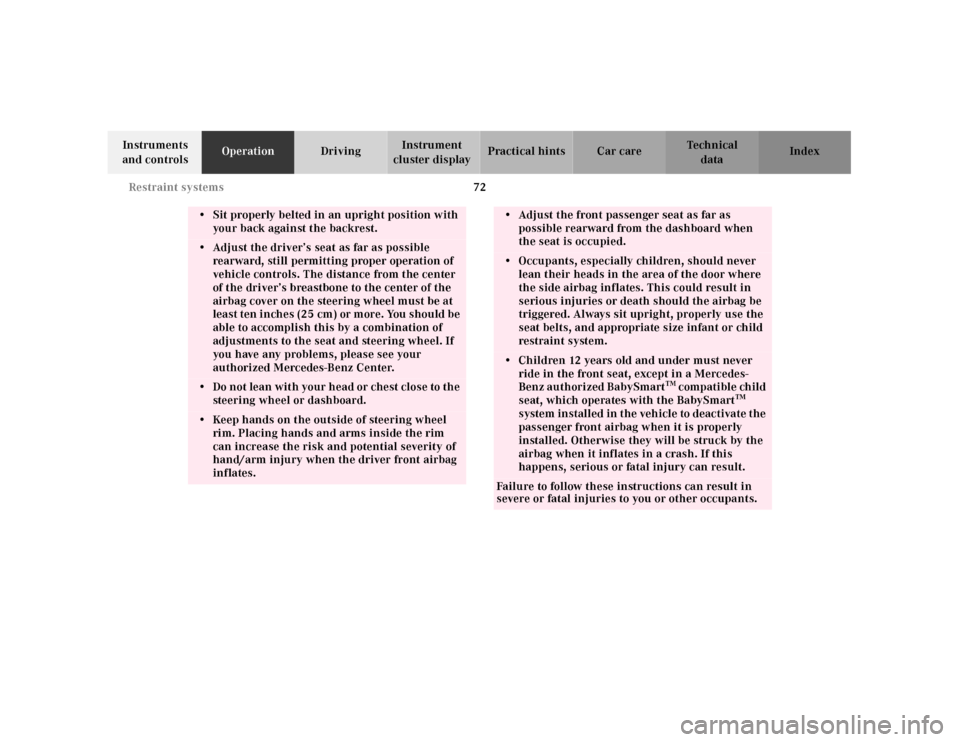
72 Restraint systems
Te ch n ica l
data Instruments
and controlsOperationDrivingInstrument
cluster displayPractical hints Car care Index
• Sit properly belted in an upright position with
your back against the backrest.• Adjust the driver’s seat as far as possible
rearward, still permitting proper operation of
vehicle controls. The distance from the center
of the driver’s breastbone to the center of the
airbag cover on the steering wheel must be at
least ten i nch es (25 cm ) or m ore. You shou ld be
able to accomplish this by a combination of
adjustments to the seat and steering wheel. If
you have any problems, please see your
authorized Mercedes-Benz Center.• Do not lean wit h your h ead or chest close to th e
steering wheel or dashboard.• Keep hands on the outside of steering wheel
rim. Placing hands and arms inside the rim
can increase the risk and potential severity of
hand/arm injury when the driver front airbag
inflates.
• Adjust the front passenger seat as far as
possible rearward from the dashboard when
the seat is occupied.• Occupants, especially children, should never
lean their heads in the area of the door where
the side airbag inflates. This could result in
serious injuries or death should the airbag be
triggered. Always sit upright, properly use the
seat belts, and appropriate size infant or child
restraint system.• Children 12 years old and under must never
ride in the front seat, except in a Mercedes-
Benz authorized BabySmart
TM c om p at i bl e ch i l d
seat, which operates with the BabySmart
TM
system installed in t he veh icle to deac tivate t he
passenger front airbag when it is properly
installed. Otherwise they will be struck by the
airbag when it inflates in a crash. If this
happens, serious or fatal injury can result.
Failure to follow these instructions can result in
severe or fatal injuries to you or other occupants.
Page 76 of 329
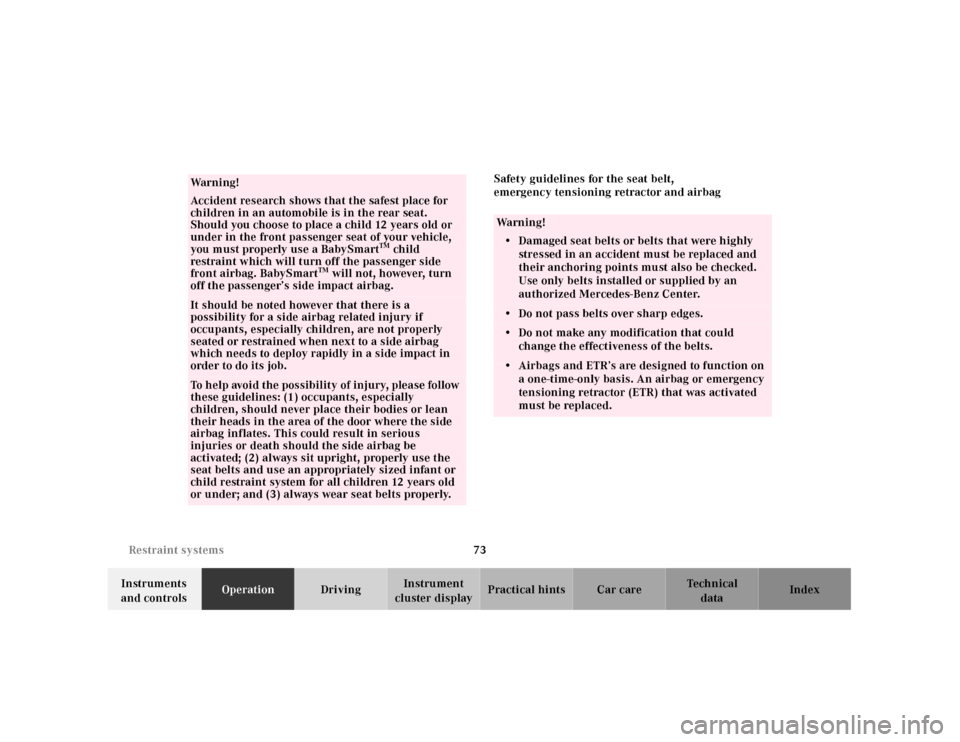
73 Restraint systems
Te ch n ica l
data Instruments
and controlsOperationDrivingInstrument
cluster displayPractical hints Car care IndexSafety guidelines for the seat belt,
emergency tensioning retractor and airbag
Wa r n i n g !
Accident research shows that the safest place for
children in an automobile is in the rear seat.
Should you choose to place a child 12 years old or
under in the front passenger seat of your vehicle,
you m ust properly use a BabySmart
TM child
restraint which will turn off the passenger side
front airbag. BabySmart
TM will not, however, turn
off the passenger’s side impact airbag.
It should be noted however that there is a
possibility for a side airbag related injury if
occupants, especially children, are not properly
seated or restrained when next to a side airbag
which needs to deploy rapidly in a side impact in
order to do its job.To help avoid the possibility of injury, please follow
these guidelines: (1) occupants, especially
children, should never place their bodies or lean
their heads in the area of the door where the side
airbag inflates. This could result in serious
injuries or death should the side airbag be
activated; (2) always sit upright, properly use the
seat belts and use an appropriately sized infant or
child restraint system for all children 12 years old
or under; and (3) always wear seat belts properly.
Wa r n i n g !
• Damaged seat belts or belts that were highly
stressed in an accident must be replaced and
their anchoring points must also be checked.
Use only belts installed or supplied by an
authorized Mercedes-Benz Center.• Do not pass belts over sharp edges.• Do not make any modification that could
change the effectiveness of the belts.• Airbags and ETR’s are designed to function on
a one-time-only basis. An airbag or emergency
tensioning retractor (ETR) that was activated
must be replaced.
Page 78 of 329
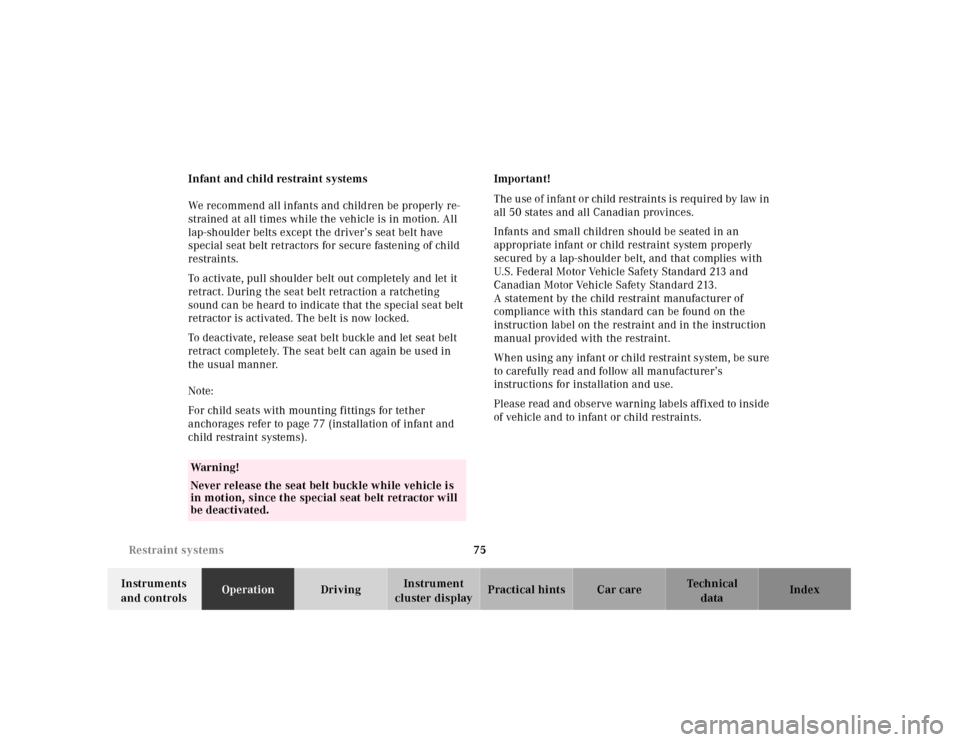
75 Restraint systems
Te ch n ica l
data Instruments
and controlsOperationDrivingInstrument
cluster displayPractical hints Car care Index Infant and child restraint systems
We recommend all infants and children be properly re-
strained at all times while the vehicle is in motion. All
lap-shoulder belts except the driver’s seat belt have
special seat belt retractors for secure fastening of child
restraints.
To activate, pull shoulder belt out completely and let it
retract. During the seat belt retraction a ratcheting
sound can be heard to indicate that the special seat belt
retractor is activated. The belt is now locked.
To deactivate, release seat belt buckle and let seat belt
retract completely. The seat belt can again be used in
the usual manner.
Note:
For child seats with mounting fittings for tether
anchorages refer to page 77 (installation of infant and
child restra int systems).Important!
The u se of infa nt or child restraints is required by law in
all 50 states and all Canadian provinces.
Infants and small children should be seated in an
appropriate infant or child restraint system properly
secured by a lap-shoulder belt, and that complies with
U.S. Federal Motor Vehicle Safety Standard 213 and
Canadian Motor Vehicle Safety Standard 213.
A statement by the child restraint manufacturer of
compliance with this standard can be found on the
instruction label on the restraint and in the instruction
manual provided with the restraint.
Wh en using any infant or ch il d restraint system, be su re
to carefully read and follow all manufacturer’s
instructions for installation and use.
Please read and observe warning labels affixed to inside
of vehicle and to infant or child restraints.
Wa r n i n g !
Never release the seat belt buckle while vehicle is
in motion, since the special seat belt retractor will
be deactivated.
Page 79 of 329
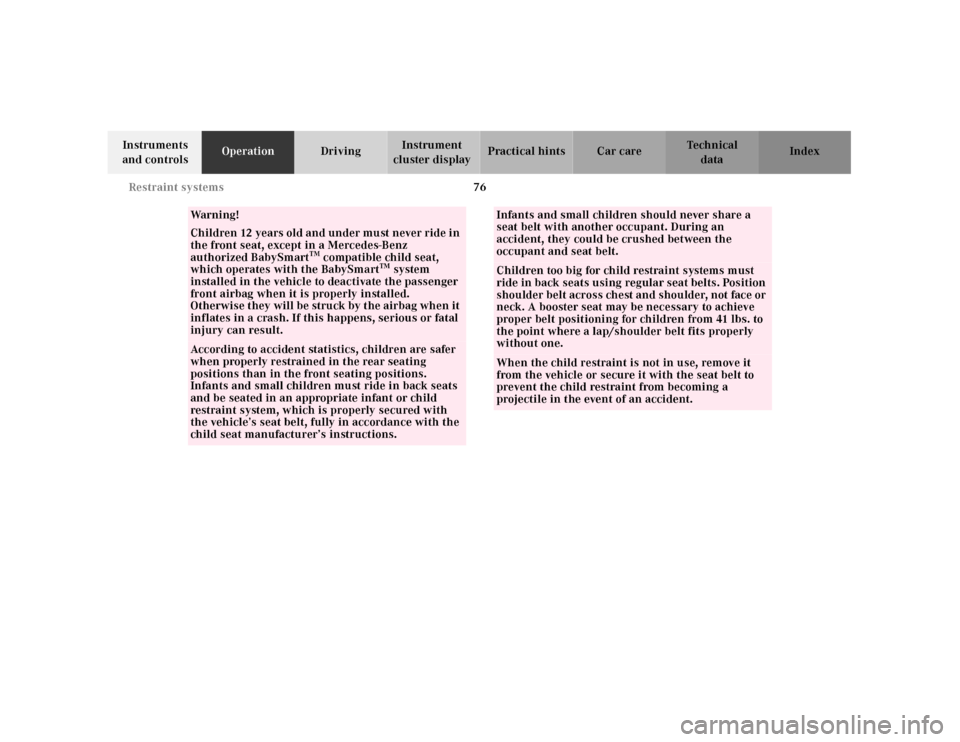
76 Restraint systems
Te ch n ica l
data Instruments
and controlsOperationDrivingInstrument
cluster displayPractical hints Car care Index
Wa r n i n g !
Children 12 years old and under must never ride in
the front seat, except in a Mercedes-Benz
authorized BabySmart
TM compatible child seat,
which operates with the BabySmart
TM system
installed in the vehicle to deactivate the passenger
front airbag when it is properly installed.
Otherwise t hey will be stru ck by t he airbag wh en it
inflates in a crash. If this happens, serious or fatal
injury can result.
According to accident statistics, children are safer
when properly restrained in the rear seating
positions than in the front seating positions.
Infants and small children must ride in back seats
and be seated in an appropriate infant or child
restraint system, which is properly secured with
the vehicle’s seat belt, fully in accordance with the
child seat manufacturer’s instructions.
Infants and small children should never share a
seat belt with another occupant. During an
accident, they could be crushed between the
occupant and seat belt.Children too big for child restraint systems must
ride in back seats using regular seat belts. Position
shou lder belt across ch est and shou lder, not fac e or
neck. A booster seat may be necessary to achieve
proper belt positioning for children from 41 lbs. to
the point where a lap/shoulder belt fits properly
without one.When the child restraint is not in use, remove it
from the vehicle or secure it with the seat belt to
prevent the child restraint from becoming a
projectile in the event of an accident.
Page 80 of 329
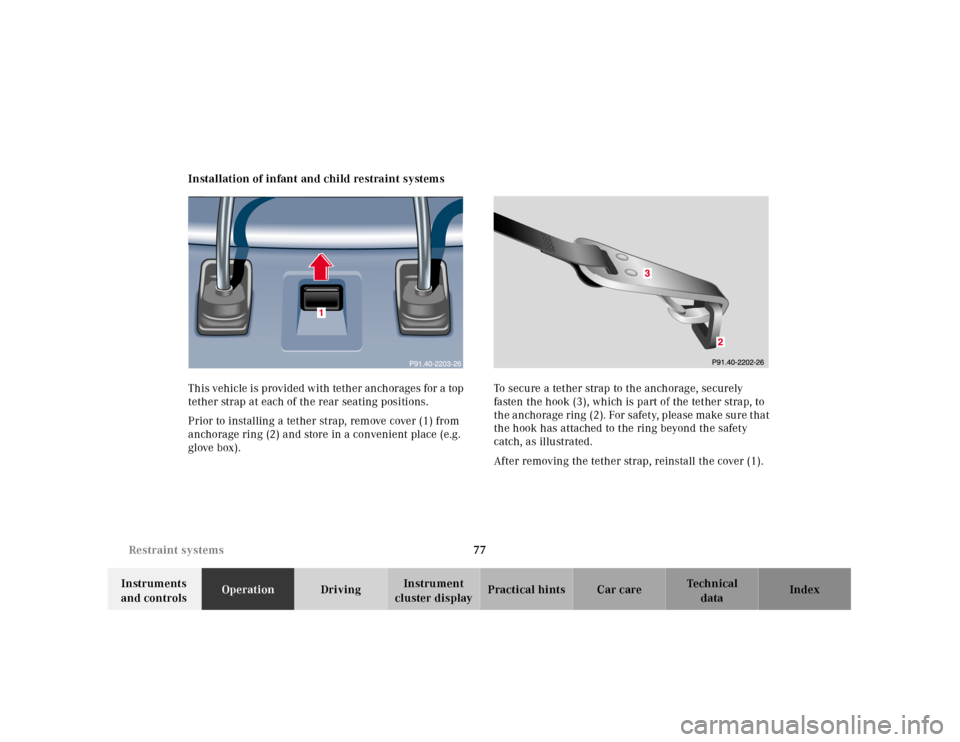
77 Restraint systems
Te ch n ica l
data Instruments
and controlsOperationDrivingInstrument
cluster displayPractical hints Car care Index Installation of infant and child restraint systems
This vehicle is provided with tether anchorages for a top
tether strap at each of the rear seating positions.
Prior to installing a tether strap, remove cover (1) from
anchorage ring (2) and store in a convenient place (e.g.
glove box).To secure a tether strap to the anchorage, securely
fasten the hook (3), which is part of the tether strap, to
the anchorage ring (2). For safety, please make sure that
the hook has attached to the ring beyond the safety
catch, as illustrated.
After removing the tether strap, reinstall the cover (1).
1
Page 233 of 329
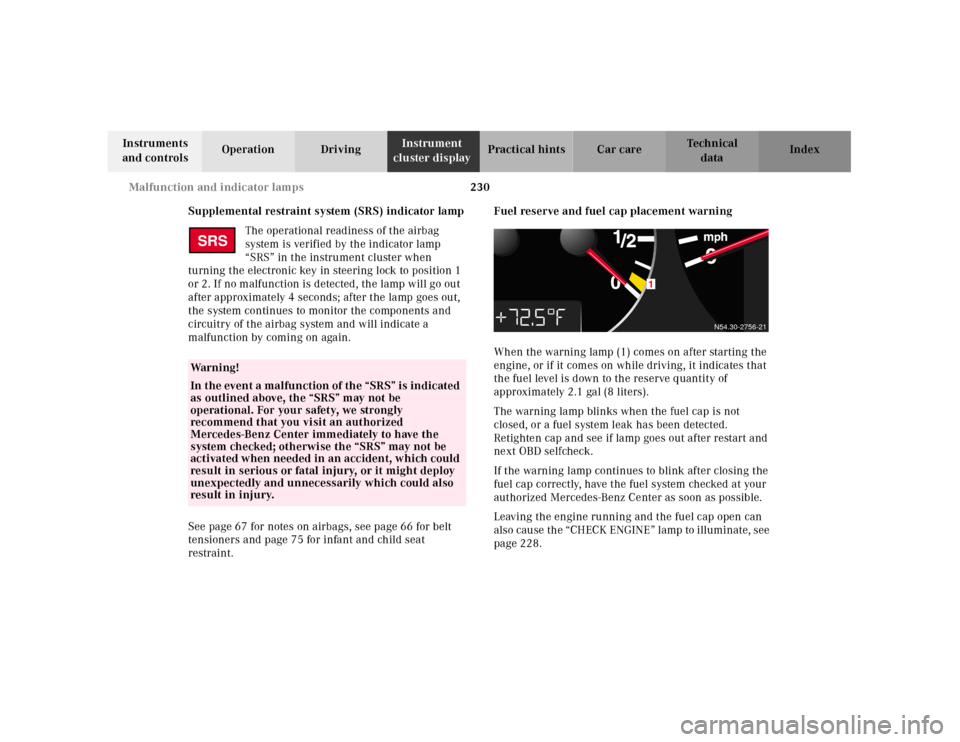
230 Malfunction and indicator lamps
Te ch n ica l
data Instruments
and controlsOperation DrivingInstrument
cluster displayPractical hints Car care Index
Supplemental restraint system (SRS) indicator lamp
The operational readiness of the airbag
system is verified by the indicator lamp
“SRS” in the instrument cluster when
turning the electronic key in steering lock to position 1
or 2. If no malfunction is detected, the lamp will go out
after approximately 4 seconds; after the lamp goes out,
the system continues to monitor the components and
circuitry of the airbag system and will indicate a
malfunction by coming on again.
See page 67 for notes on airbags, see page 66 for belt
tensioners and page 75 for infant and child seat
restraint.Fuel reserve and fuel cap placement warning
When the warning lamp (1) comes on after starting the
engine, or if it comes on while driving, it indicates that
the fuel level is down to the reserve quantity of
approximately 2.1 gal (8 liters).
The warning lamp blinks when the fuel cap is not
closed, or a fuel system leak has been detected.
Retighten cap and see if lamp goes out after restart and
next OBD selfcheck.
If the warning lamp continues to blink after closing the
fuel cap correctly, have the fuel system checked at your
authorized Mercedes-Benz Center as soon as possible.
Leaving the engine running and the fuel cap open can
also cau se th e “CH ECK ENGINE ” l amp to ill uminate, see
page 228.
Wa r n i n g !
In t he event a malfu nction of th e “SRS” is indic ated
as outlined above, the “SRS” may not be
operational. For your safety, we strongly
recommend that you visit an authorized
Mercedes-Benz Center immediately to have the
system checked; otherwise the “SRS” may not be
activated when needed in an accident, which could
result in serious or fatal injury, or it might deploy
unexpectedly and unnecessarily which could also
result in injury.SRS
1
N54.30-2756-21
Page 318 of 329
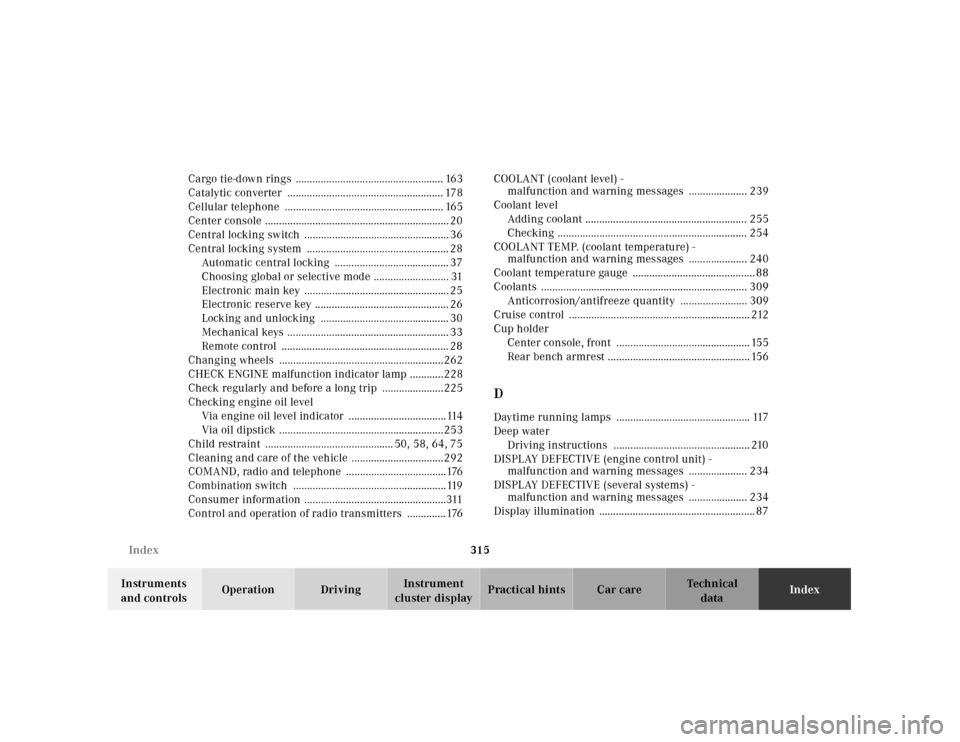
315 Index
Te ch n ica l
data Instruments
and controlsOperation DrivingInstrument
cluster displayPractical hints Car careIndex Cargo tie-down rings ..................................................... 163
Catalytic converter ........................................................ 178
Cellular telephone ......................................................... 165
Center console .................................................................. 20
Central locking switch .................................................... 36
Central locking system ................................................... 28
Automatic central locking ......................................... 37
Choosing global or selective mode ........................... 31
Electronic main key .................................................... 25
Electronic reserve key ................................................ 26
Locking and unlocking .............................................. 30
Mechanical keys .......................................................... 33
Remote control ............................................................ 28
Changing wheels ...........................................................262
CHECK ENGINE malfunction indicator lamp ............228
Check regularly and before a long trip ......................225
Checking engine oil level
Via engine oil level indicator ...................................114
Via oil dipstick ...........................................................253
Child restraint .............................................. 50, 58, 64, 75
Cleaning and care of the vehicle .................................292
COMAND, radio and telephone ....................................176
Combination switch .......................................................119
Consumer information ...................................................311
Control and operation of radio transmitters ..............176COOLANT (coolant level) -
malfunction and warning messages ..................... 239
Coolant level
Adding coolant .......................................................... 255
Checking .................................................................... 254
COOLANT TEMP. (coolant temperature) -
malfunction and warning messages ..................... 240
Coolant temperature gauge ............................................ 88
Coolants .......................................................................... 309
Anticorrosion/antifreeze quantity ........................ 309
Cruise control ................................................................. 212
Cup holder
Center console, front ................................................ 155
Rear bench armrest ................................................... 156
DDaytime running lamps ................................................ 117
Deep water
Driving instructions ................................................. 210
DISPLAY DEFECTIVE (engine control unit) -
malfunction and warning messages ..................... 234
DISPLAY DEFECTIVE (several systems) -
malfunction and warning messages ..................... 234
Display illumination ........................................................ 87
Page 321 of 329
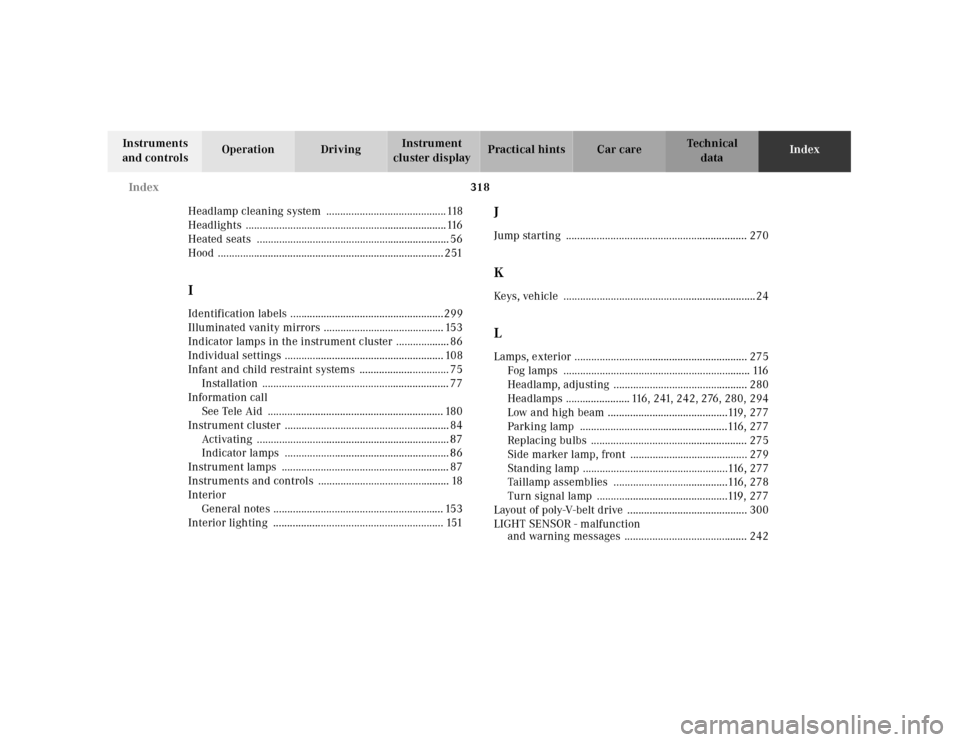
318 Index
Te ch n ica l
data Instruments
and controlsOperation DrivingInstrument
cluster displayPractical hints Car careIndex
Headlamp cleaning system ...........................................118
Headlights ........................................................................116
Heated seats ..................................................................... 56
Hood ................................................................................. 251
IIdentification labels .......................................................299
Illuminated vanity mirrors ........................................... 153
Indicator lamps in the instrument cluster ................... 86
Individual settings ......................................................... 108
Infant and child restraint systems ................................ 75
Installation ................................................................... 77
Information call
See Tele Aid ............................................................... 180
Instrument cluster ........................................................... 84
Activating ..................................................................... 87
Indicator lamps ........................................................... 86
Instrument lamps ............................................................ 87
Instruments and controls ............................................... 18
Interior
General notes ............................................................. 153
Interior lighting ............................................................. 151
JJump starting ................................................................. 270KKeys, vehicle .....................................................................24LLamps, exterior .............................................................. 275
Fog lamps ................................................................... 116
Headlamp, adjusting ................................................ 280
Headlamps ....................... 116, 241, 242, 276, 280, 294
Low and high beam ...........................................119, 277
Parking lamp .....................................................116, 277
Replacing bulbs ........................................................ 275
Side marker lamp, front .......................................... 279
Standing lamp ....................................................116, 277
Taillamp assemblies .........................................116, 278
Turn signal lamp ...............................................119, 277
Layout of poly-V-belt drive ........................................... 300
LIGHT SENSOR - malfunction
and warning messages ............................................ 242